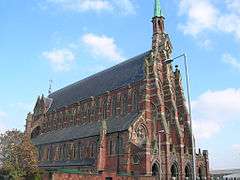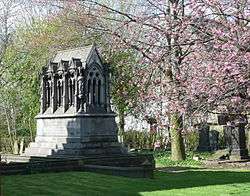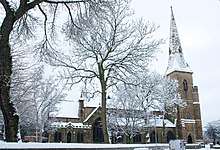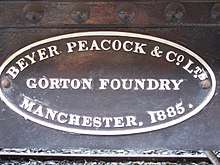Gorton
| Gorton | |
|---|---|
 Gorton Monastery | |
 Gorton Gorton shown within Greater Manchester | |
| Population | 36,055 (2011) |
| OS grid reference | SJ885965 |
| Metropolitan borough | |
| Metropolitan county | |
| Region | |
| Country | England |
| Sovereign state | United Kingdom |
| Post town | MANCHESTER |
| Postcode district | M18 |
| Dialling code | 0161 |
| Police | Greater Manchester |
| Fire | Greater Manchester |
| Ambulance | North West |
| EU Parliament | North West England |
| UK Parliament | |
Gorton is an area of Manchester in North West England, southeast of the city centre. The population at the 2011 census was 36,055.[1][2] Neighbouring areas include Audenshaw, Denton, Levenshulme, and Reddish .
A major landmark is Gorton Monastery, a 19th-century High Victorian Gothic former Franciscan friary.
History
According to local folklore, Gorton derives its name from Gore Town, due to a battle between the Saxons and Danes nearby.[3][4] This has been dismissed by historians as "popular fancy".[5] The name Gorton means "dirty farmstead",[6] perhaps taking its name from the Gore Brook, or dirty brook, which still runs through the township to-day. The brook may have acquired that name because of the dirty appearance of its water, perhaps caused by discolouration due to peat or iron deposits.[7]
In medieval times, the district was a township of the ancient parish of Manchester in the Salford Hundred of Lancashire.
Manchester City F.C. was founded as St. Mark's (West Gorton) in 1880. The club was formed with the aim of binding the local community and to combat a form of gang warfare called scuttling that existed in the 1870s.[8][9] The rector's daughter, Anna Connell, is widely credited as the founder, although churchwarden William Beastow is believed to be the person who played the main part in creating sporting activities for the parish. In 1875, St. Mark's Cricket Club are known to have played and this evolved into the football club later in the decade.[10] The first recorded football game was played in November 1880.[11]
A Blackfoot Sioux chief named Charging Thunder came to Salford aged 26 as part of Buffalo Bill's Wild West Show in 1903. Like many Lakota tribesmen, Charging Thunder was an exceptional horseman and performed thrilling stunts in Buffalo Bill's show in front of huge crowds, on the site of what is now the Lowry in Salford Quays. But when the show rolled out of town, he remained in London. He married Josephine, an American horse trainer who had just given birth to their first child, Bessie and together they settled in Darwen, before moving to Gorton. His name was changed to George Edward Williams, after registering with the British immigration authorities to enable him to find work. Williams ended up as an elephant keeper at the Belle Vue Zoo. He died on 28 July 1929 from pneumonia aged fifty-two. His interment was in Gorton's cemetery.
20th century
The world-famous Belle Vue Zoological Gardens, comprising a zoo, gardens, amusement park, exhibition complex and speedway stadium, was opened in 1836 in Gorton and became one of the leading attractions in the UK. The site spanned 165 acres of land and attracted over two million visitors a year.[12] The zoo was the third-largest in the UK, and the exhibition hall held concerts from a range of national and international artists, such as Jimi Hendrix and The Rolling Stones. After 141 years, the zoo closed in 1977, with the rest of the site finally cleared for redevelopment in 1982.
Myra Hindley, convicted of taking part in the Moors Murders in 1966, grew up in Gorton.[13] She and Ian Brady lived there at the time of the first three Moors murders, before moving to Hattersley in 1964, committing two further murders there before they were arrested in October 1965. Their first victim, Pauline Reade (who died in July 1963 aged 16, but whose body was not found for 24 years), was a Gorton resident and a neighbour of Hindley.[14] The third victim, Keith Bennett, was also from Gorton. He was last seen alive on 16 June 1964. His body has yet to be found, and Pauline Reade's body was not found until 1987.[15]
Economy and Development
The Industrial Revolution brought work and industry to Gorton in the form of locomotive factories, including that of Beyer, Peacock and Company. Today these sites continue to employ workers in a variety of fields, from local private businesses to national companies, including the manufacturing headquarters of Iceland [16]. A number of retail and recreation sites are also a source of local employment for many in the area, such as the TV and film production studio, Space Studios, which employs up to 300 people[17]. Less than 3 miles from the centre of Manchester, Gorton is also made up of many tertiary sector workers who commute into the city.
The popular television series Shameless, which aired on Channel 4, was mainly filmed in West Gorton. The parade of shops used for filming in the initial series was built on the site of St. Mark's Church, Clowes Street, the birthplace of Manchester City F.C.[18] The area has since been demolished and redeveloped with various new social and private housing,[19] new Medical Centre, retail and commercial spaces, as well as the "Space Project", a large-scale television and film production studio with six sound and prop stages used to film various BBC and ITV productions.
In 2006, Manchester City Council started a multimillion-pound redevelopment of the Gorton District Shopping Centre. The small market and retail area were demolished and work started in late 2007 to construct a new market hall and Tesco Extra hypermarket on the site. In July 2008, the new Manchester Gorton Market Hall was opened to the public.[20] The construction of the new hypermarket and neighbouring petrol station continued, and in late October 2008, the new Tesco Extra store opened its doors for trading. Further retail outlets were developed near this site along Hyde Road, including Subway, Coral and Age UK.[21]
Geography
Belle Vue is a locality within Gorton, as are West Gorton, which was included in the City of Manchester in 1890, whereas the remainder of Gorton wasn't until 1909, thanks largely to the work of councillor Joseph Henry Williamson, then Chairman of Gorton Urban District Council, and Abbey Hey, mostly a residential district, but also well-known locally as the location of Wright Robinson College.
The area south of the former Roman road, Hyde Road, and between Belle Vue and Reddish is a historic area in which various ancient tools and weapons have been unearthed from various historic battles that took place there.[22] Many local placenames allude to this history, including Winning Hill, also known as Ryder Brow, a locality within Gorton that contains many topographical features, including Bottom o’ th’ Brow at the base of a valley and Gore Brook that runs through Gorton, flowing west to the river Mersey. Much of this area contains the Gore Brook Valley Conservation Area. Ryder Brow is served by Ryder Brow railway station.
Gorton also has several allotments and parks which are supported through the Gorton Horticultural Society.
Landmarks and attractions
Gorton is home to Gorton Monastery, a Franciscan, 19th century High Victorian Gothic friary. This has been renovated and secularised: it was previously derelict after the friars moved out. The parish left by the Friars came under the care of the Diocese of Salford. St Francis of Assisi RC Church on Textile Street, Gorton, and Sacred Heart Church, Levenshulme Road, Gorton, now form part of the R.C. Parish of Sacred Heart and St. Francis. Other churches in Gorton which were designed by notable architects include the Brookfield Unitarian Church on Hyde Road, built by Richard Peacock [23] and the Mount Olivet Apostolic Church (originally the Anglican church of Our Lady of Mercy and St Thomas of Canterbury) on Mount Road, which was built by Walter Tapper in 1927.[24]
Gorton Heritage Trail is a public trail with 20 sites of interest. The trail is partly semi-rural, largely located within the Gore Brook Valley Conservation Area, and highlights various local landmarks, including ecological and topographical sites, and grade-listed monuments and buildings. The trail starts in Sunny Brow Park, and leads northwards to Debdale Park, following the reverse course of Gore Brook.[25]


There are a number of grade-listed buildings in Gorton, most notably Gorton Monastery. Other listed buildings and monuments include:
- Anglican Church of Saint Benedict - this is the site of the Manchester Climbing Centre
- St James' Church
- The Plough Inn
- Brookfield Unitarian Church & Brookfield Sunday School
- Peacock Mausoleum - this is situated on the grounds of Brookfield Church along with many other memorial stones including that of James Rider of the Gorton Philharmonic, The Grimshaws of Stansfield Lodge (including Joseph Stansfield Grimshaw Esq.), and various workers of Gorton Foundry
- Brookfield Lodge
- 46-50 Far Lane
- 56-60 Tan Yard Brow
- Springbank Farmhouse
- 60-66 High Bank Lane
- Gorton House - situated within Debdale Park
- Our Lady and St Thomas of Canterbury Church
- Beswick Co-operative Society Building [26]
Gorton was home to the world-famous Belle Vue Zoological Gardens from 1836 until its closure in the 1980s. At its peak, Belle Vue attracted more than two million visitors a year.[27]
Transport
Railways


Gorton is bordered to the north by the Piccadilly-Glossop train line (formerly the Great Central Railway[28]), and is served by several train stations including Gorton railway station, which opened in 1842 as Gorton and Openshaw and was replaced in 1906. It is still in operation today on the Hope Valley Line and is served by train services between Manchester Piccadilly and Glossop/Hadfield.[29] The station is mentioned in the 1964 song "Slow Train" by Flanders and Swann, referred to as "Openshaw".
Other stations in the area include Ashburys, Belle Vue and Ryder Brow
Another railway station in the Gorton area was Hyde Road which opened in 1882 on the ill-fated Fallowfield Loop railway line; both the station and the line closed to passengers in 1958. Hyde Road railway station had a brief revival in 1987 when it played an important role in the early development of the Manchester Metrolink system. A temporary station called Debdale Park was constructed on the site of the Hyde Road railway station to host a public exhibition of Project Light Rail, in which a train on loan from the fledgling Docklands Light Railway system in London was driven along a short stretch of track to demonstrate the light rail/tram network in Manchester being planned. This was the first ever light rail vehicle seen in operation in Manchester. Soon after the demonstration, the Fallowfield line was dismantled and has since been converted by Sustrans into a cycle track, the Fallowfield Loop, which runs from Debdale Park to St Werburgh's Road Metrolink station in Chorlton-cum-Hardy.[30][31]
In 1849, a locomotive works was built for the Manchester, Sheffield and Lincolnshire Railway, later the Great Central Railway, known locally as the Gorton Tank. It carried out repairs and major overhauls, producing new boilers and all LNER castings. There was also a carriage and wagon works which had been built in 1881 which carried out light repairs. Both were closed in 1962.[32] Gorton was also the home of the Beyer-Peacock locomotive Company at Gorton Foundry, from 1854, until it closed in 1966. One of the company's partners, Richard Peacock subsequently became Liberal MP for Gorton in the 1885 general election.
Governance
The former municipal borough of Manchester was created in 1838 and elevated to a city in 1853. Part of Gorton township was included in the city in 1890. The remaining part of the township became an Urban District of the administrative county of Lancashire in 1894. A small part of the urban district was transferred to the city of Manchester in 1901 and the remaining area was fully incorporated into Manchester in 1909.
Gorton forms part of the Manchester Gorton parliamentary constituency, comprising Gorton North, Gorton South, Fallowfield, Longsight, Levenshulme, Rusholme and Whalley Range.[33] The Gorton area is split into two electoral wards – Gorton North and Gorton South. Father of the House and Britain's longest serving backbench MP, Sir Gerald Kaufman, represented the Gorton area (Ardwick followed by Manchester Gorton) for 47 years until his death in February 2017.[34] Manchester Gorton's current MP is Afzal Khan.
Performing arts and sport
Gorton Philharmonic Orchestra was founded in 1854 and is an amateur orchestra.[35] The folk comedy group Gorton Tank were based in Gorton and were popular in the Manchester area. The painter Michael Gutteridge was born in Gorton. The Gorton Morris Men were responsible for reviving the rushcart ceremony in Gorton.[36] Manchester City F.C. were founded as St. Mark's (West Gorton) in 1880. Abbey Hey F.C. club is in Gorton. "Bouncing Billy Barker" was a local man who specialised in jumping feats.[37]
Notable residents
John Thaw, actor best known for his role as Inspector Morse, was born in West Gorton.[38]
Billy Meredith, former footballer lived on Clowes street and married at St Mark's Church.
Tommy Johnson, a former footballer for Manchester City F.C., lived in Gorton.
Nicky Butt, former England and Manchester United footballer, was born in Gorton.
Bob Berry, former England and Lancashire cricketer, was born in Gorton.
Jeff Williams, 1980 Olympic cyclist, was born in Gorton.
Thomas Evenson, Olympian silver medalist in the 3000 meters steeplechase at the 1932 Los Angeles Olympics, was born in Gorton.[39]
George Wilkinson, three-time Olympic water polo champion, born in Gorton.
Brian Statham, former England and Lancashire cricketer, born in Gorton.
Samuel Gorton, early settler of North America and 5th President of Rhode Island, was born and raised in Gorton in the 1590s.
See also
References
Notes
- ↑ "City of Manchester ward/Gorton South population 2011". Retrieved 5 January 2016.
- ↑ "City of Manchester Ward/Gorton North population 2011". Retrieved 5 January 2016.
- ↑ Booker (1857), p. 197.
- ↑ Harland & Wilkinson 1993, pp. 26–29
- ↑ Farrer & Brownbill 1911, pp. 275–279.
- ↑ A ditch in time, BBC Online, 1 August 2008, retrieved 5 January 2009
- ↑ Cooper 2007, p. 80
- ↑ James 1997, pp. 9–12
- ↑ James 2008, pp. 55–64
- ↑ James 2008, pp. 55–58.
- ↑ James 1997, p. 12
- ↑ Cronin, Jill; Rhodes, Frank (1999), Belle Vue, Tempus, ISBN 0-7524-1571-9
- ↑ Murder on the Moors: The Ian Brady and Myra Hindley Story – Crime Library, archived from the original on 30 December 2007
- ↑ "The 1960s", Tameside Advertiser, M.E.N. Media, 9 October 2003
- ↑ Bunyan, Nigel; Steele, John (14 November 2001), "Hindley map shows way to grave", The Telegraph, London: Telegraph Media Group
- ↑ Iceland Manufacturing
- ↑ "Manchester production studio behind Cold Feet in £14m upgrade"
- ↑ James (2008), p. 373.
- ↑ "Place North West | West Gorton housing plans approved". Place North West. 2014-09-29. Retrieved 2017-06-14.
- ↑ "Work starts on £1.7m market"
- ↑ Tesco Activity report
- ↑ Gore Brook Valley Conservation Area “History”
- ↑ "Brookfield Church Memorabilia". Archived from the original on 6 October 2014.
- ↑ "The Churches". Sir Walter Tapper & His Churches. Retrieved 15 September 2012.
- ↑ “Take a walk on the wild side”, Manchester Evening News
- ↑ Stuff, Good. "Listed Buildings in Gorton North Ward, Manchester". www.britishlistedbuildings.co.uk. Retrieved 2017-06-15.
- ↑ Jill., Cronin,; Frank., Rhodes, (1999). Belle Vue. Tempus. ISBN 0752415719. OCLC 43031759.
- ↑ "Townships: Gorton | British History Online". www.british-history.ac.uk. Retrieved 2017-06-15.
- ↑ Jowett's Railway Centres Volume 1 (Alan Jowett, published PSL 1993)
- ↑ "Debdale Park". Subterranea Britannica. Disused Stations. Retrieved 15 March 2010.
- ↑ Holt, David (1992). Manchester Metrolink. Sheffield: Platform 5 Pub. pp. 24–25. ISBN 1-872524-36-2.
- ↑ The Gorton railway works subsequently became an engineering and test centre for the computer division of Ferranti, later ICL
- ↑ England., Boundary Commission for (2007). Fifth periodical report : presented to Parliament pursuant to section 3(5) of the Parliamentary Constituencies Act 1986. Sationery Office. ISBN 0101703228. OCLC 85783106.
- ↑ "Labour MP Gerald Kaufman dies at 86". The Independent. 2017-02-26. Retrieved 2017-06-15.
- ↑ Gorton Philharmonic Orchestra, retrieved 10 April 2009
- ↑ Gorton Rushcart revival, archived from the original on 31 May 2008, retrieved 10 April 2009
- ↑ Billy Barker, retrieved 10 April 2009
- ↑ John Thaw, retrieved 21 July 2009
- ↑ "Gorton Olympians". Archived from the original on 2 November 2012. Retrieved 3 April 2010.
Bibliography
- Booker, John (1857), A History of the Ancient Chapels of Didsbury and Chorlton, Manchester: Chetham Society
- Cooper, Glynis (2007), The Illustrated History of Manchester's Suburbs; updated edition, Derby: The Breedon Books Publishing Company, ISBN 978-1-85983-592-0 (first published in 2002)
- Farrer, W.; Brownbill, J., eds. (1911), "Townships: Gorton", A History of the County of Lancaster [Victoria County History], 4, , pp. 275–279, retrieved 31 January 2009
- Harland, John; Wilkinson, Thomas Turner (1993) [1873], Lancashire Legends, Traditions, Llanerch Press, ISBN 1-897853-06-8
- Cooper – Manchester Suburbs, ISBN 1-85983-592-9, retrieved 10 April 2009
- James, Gary (2008), Manchester – A Football History, James Ward, ISBN 978-0-9558127-0-5
- James, Gary (1997), Manchester The Greatest City, Polar Publishing, ISBN 1-899538-09-7
External links
![]()